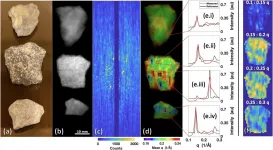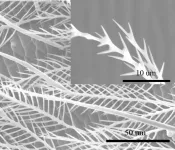(Press-News.org) The routes and schedules of public transit, the presence or absence of sidewalks, the availability of different transportation options, and the design of highways that divide cities--these are examples of aspects of transportation systems that can profoundly impact underserved communities' access to basic needs like jobs, health care, education and even food.
A new study by University of Michigan researchers reveals common barriers that transportation decision-makers face in considering these issues and addressing them.
To conduct the study, a team from a multidisciplinary project involving engineering, public policy and data science interviewed 59 transportation practitioners in government, industry, the nonprofit sector and academia.
Increasing the equitable access to resources that transportation provides has risen on transportation practitioners' priority lists in recent decades, to the point that 80% of those interviewed said that they directly address social equity and fairness in their work. But common barriers they face include the need for more and better data on equity and transportation needs, as well as more effective ways to measure transportation equity.
How transportation system can perpetuate inequities
Historically, transportation systems have deepened inequity by, for instance, building highways that cut off and divide Black and low-income neighborhoods, among other decisions that prioritized the convenience of white residents. In addition to not repeating these injustices, many modern transportation practitioners view their role as having a responsibility to actively improve access to transportation. Poor mobility options can make it difficult for people in low-income communities to access healthy food, attend school, find and keep jobs, and receive adequate health care. It eats up time that people with limited resources can't afford to waste.
"There's a woman in Detroit who spends three hours riding the bus with her kid to go to school every day. That's three hours she's not earning the money that might help her move closer to that school or buy a car to reduce the commute. It's three hours she can't spend preparing healthy food, from a grocery store that might be as inaccessible as the school, and could lead to long term health problems. These inequities stack," said Kaylla Cantilina, a Ph.D. student in design science and first author on the paper in the journal
Transportation Research Record.
Barriers to progress in transportation equity
Practitioners cited these crucial barriers to improving transportation equity:
Collecting and connecting data sets: Policymakers said they couldn't get access to data in private companies, and private companies said that they couldn't seamlessly connect public data sets with their own data.
Lack of information on needs: Transportation practitioners need more information about the gaps experienced by underserved communities--where they need to go, when they need to go there and why current services are inadequate. In some cases, moving people won't be the sole solution. Cities may need to work with schools, hospitals and grocery stores to support the populations that need them.
"A lot of problems aren't purely transportation, but if we get more information about those problems, then we can address the pieces that relate to transportation," Cantilina said..
How better communication could lead to solutions
One potential solution is to improve communication between engineers and policymakers, and between data scientists and policymakers.
"Transportation equity practitioners, including engineers and data scientists, cannot develop solutions isolated from contexts and communities," said Shanna Daly, U-M associate professor of mechanical engineering who co-authored the paper.
"Transportation work has both technical and social dimensions that must be considered in parallel, even in disciplines that have been conventionally 'boxed off' as having only a technical focus."
As for how to facilitate those connections, some practitioners shared their approaches that could serve as models--such as a partnership between a city and a ride-sharing or automotive company to share data under agreed-upon parameters. Another example came from a state metropolitan planning organization, which handles regional mapping, allocation of funding and regulation of transportation around cities. The organization has an open office in which departments are mixed, making it easy to solicit knowledge without asking for a meeting.
One of the surprises was that for more than half of the transportation practitioners, money wasn't considered a major barrier. But reallocating money from other projects was often a challenge. Transportation decision-makers need structures in place to advocate for apportioning money with equity in mind, the researchers said.
"If you have a clump of money that automatically goes to highway management, is it really that hard to convince people not to use all of it for the highway? Why can't we build a sidewalk on this low-income road so kids can walk to school safely? It's a matter of priority," Cantilina said.
Closing the gap between academic researchers and practitioners
The study uncovered gaps between academic research and transportation practice. Often, the academic research in transportation equity focuses on approaches and tools that are not always easily applied, Cantilina said. Meanwhile, practitioners aren't necessarily taking advantage of the groundwork laid in research, though they sometimes come to the same conclusions.
In addition, academic researchers aren't aware of many of the problems that transportation practitioners in governments, nonprofits and private companies run into. With better connections, researchers could look into more relevant questions and practitioners could avoid reinventing the wheel. One open question is how to measure transportation equity.
Better solutions would free up talent that is currently stuck at home or lost to excessively long bus rides.
"Transportation is a form of freedom," Cantilina said. "You don't have time to dream when you're trying to access the resources just to survive."
INFORMATION:
The paper is titled: "Approaches and barriers to addressing equity in transportation: Experiences of transportation practitioners."
Other authors include Robert Hampshire, currently the principal deputy assistant secretary for research and technology at the U.S. Department of Transportation, and Matt Reed, the Don B. Chaffin Collegiate Research Professor in industrial and operations engineering. Hampshire and Reed are researchers in the U-M Transportation Research Institute. Daly is also a Miller Faculty Scholar. The research is funded by the National Science Foundation.
Written by Katherine McAlpine
DARIEN, IL - A study shows that a deep neural network model can accurately predict the brain age of healthy patients based on electroencephalogram data recorded during an overnight sleep study, and EEG-predicted brain age indices display unique characteristics within populations with different diseases.
The study found that the model predicted age with a mean absolute error of only 4.6 years. There was a statistically significant relationship between the Absolute Brain Age Index and: epilepsy and seizure disorders, stroke, elevated markers of sleep-disordered breathing (i.e., apnea-hypopnea index and arousal ...
The widely studied metallic asteroid known as 16 Psyche was long thought to be the exposed iron core of a small planet that failed to form during the earliest days of the solar system. But new University of Arizona-led research suggests that the asteroid might not be as metallic or dense as once thought, and hints at a much different origin story.
Scientists are interested in 16 Psyche because if its presumed origins are true, it would provide an opportunity to study an exposed planetary core up close. NASA is scheduled to launch its Psyche mission in 2022 and arrive at the asteroid in 2026.
UArizona ...
[RALEIGH, N.C.] - How are the squirrels doing this year? The bears? The armadillos? How would you know? A new paper published June 8 sets up the framework for answering these questions across the United States by releasing the data from the first national mammal survey made up of 1,509 motion-activated camera traps from 110 sites located across all 50 states.
Unlike birds, which have multiple large-scale monitoring programs, there has been no standard way to monitor mammal populations at a national scale. To address this challenge, scientists from the North Carolina Museum of Natural Sciences and the Smithsonian Conservation Biology Institute recently collaborated ...
DURHAM, N.C. - Engineers at Duke University have demonstrated a prototype X-ray scanning machine that reveals not just the shape of an object but its molecular composition. With unprecedented resolution and accuracy, the technology could revolutionize a wide range of fields such as cancer surgery, pathology, drug inspection and geology.
Many of the ideas behind the prototype were originally conceived in the pursuit of performing better bomb detection for aviation security. In the new paper, published online May 19 in the journal Scientific Reports, the researchers adapted the technology for several targeted scientific and medical applications.
"Whether you're trying to spot a bomb in a bag or a tumor in a body, the physics is more or less the same," said ...
Watching honeybees buzz among flowers, it's easy to see how the expression "busy as a bee" arose. One of many movements a bee's body makes is the repetitive curving and straightening of its abdomen. Now, researchers reporting in ACS Applied Materials & Interfaces have found that tiny hairs reduce friction from these motions, saving energy for the industrious insects' daily activities while reducing wear and tear. This knowledge could help researchers design longer-lasting moving parts.
A bee's abdomen is divided into several tough outer plates that make up its exoskeleton. When the abdomen flexes and extends, these segments slide over each other, creating friction. However, the overlapping portions of the segments show very little wear and tear, ...
WASHINGTON, June 9, 2021 -- The World Health Organization and the Centers for Disease Control recommend keeping a certain distance between people to prevent the spread of COVID-19. These social distancing recommendations are estimated from a variety of studies, but further research about the precise mechanism of virus transport from one person to another is still needed.
In Physics of Fluids, by AIP Publishing, researchers from Stony Brook University, Harvard, ETH Zurich, and Hanyang University demonstrate normal breathing indoors without a mask ...
Summer rainfall on the Tibetan Plateau is highly predictable on multiyear timescales in large ensemble predictions, according to a research team led by ZHOU Tianjun from the Institute of Atmospheric Physics (IAP) of the Chinese Academy of Sciences.
The study, published in Science Advances on June 9, shows evidence that the predictable signal of summer rainfall across the hinterland of the Tibetan Plateau is substantially underestimated in state-of-the-art decadal prediction models.
The predictable signal is so weak that it can be concealed by unpredictable noise. "The too weak predictable signal arises from the low signal-to-noise ratios in models in comparison with the real world," ...
A new study at the University of Chicago Medicine and Washington University found that a single inhalation session with 25% nitrous oxide gas was nearly as effective as 50% nitrous oxide at rapidly relieving symptoms of treatment-resistant depression, with fewer adverse side effects. The study, published June 9 in Science Translational Medicine, also found that the effects lasted much longer than previously suspected, with some participants experiencing improvements for upwards of two weeks.
These results bolster the evidence that non-traditional treatments may be a viable option for patients whose depression is not responsive to typical antidepressant medications. It may also provide a rapidly effective treatment option for patients in crisis.
Often called "laughing gas," nitrous ...
A single, one-hour treatment that involves breathing in a mixture of oxygen and nitrous oxide -- otherwise known as laughing gas -- significantly improved symptoms in people with treatment-resistant depression, according to new data from researchers at Washington University School of Medicine in St. Louis and the University of Chicago.
In a phase 2 clinical trial, the researchers demonstrated that symptoms of depression improve rapidly following treatment with inhaled nitrous oxide. Further, they reported the benefits can last for several weeks.
The findings are published June 9 in the journal Science Translational Medicine.
"A large percentage of patients don't respond to standard antidepressant therapies -- the ...
A new study unexpectedly identified tiny deposits of elemental copper and iron within the brains of two deceased people with Alzheimer's disease. The findings could help scientists better understand how these elemental metals, which were uncovered in the cores of amyloid plaques, contribute to neurodegenerative diseases and could point to a target for alternative Alzheimer's therapies. While enzymes and proteins containing positively charged copper and iron ions have been known to control key processes in the human brain, little has been known about how the organ mineralizes iron and copper, including the formation of elemental metallic nanoparticles, which ...




